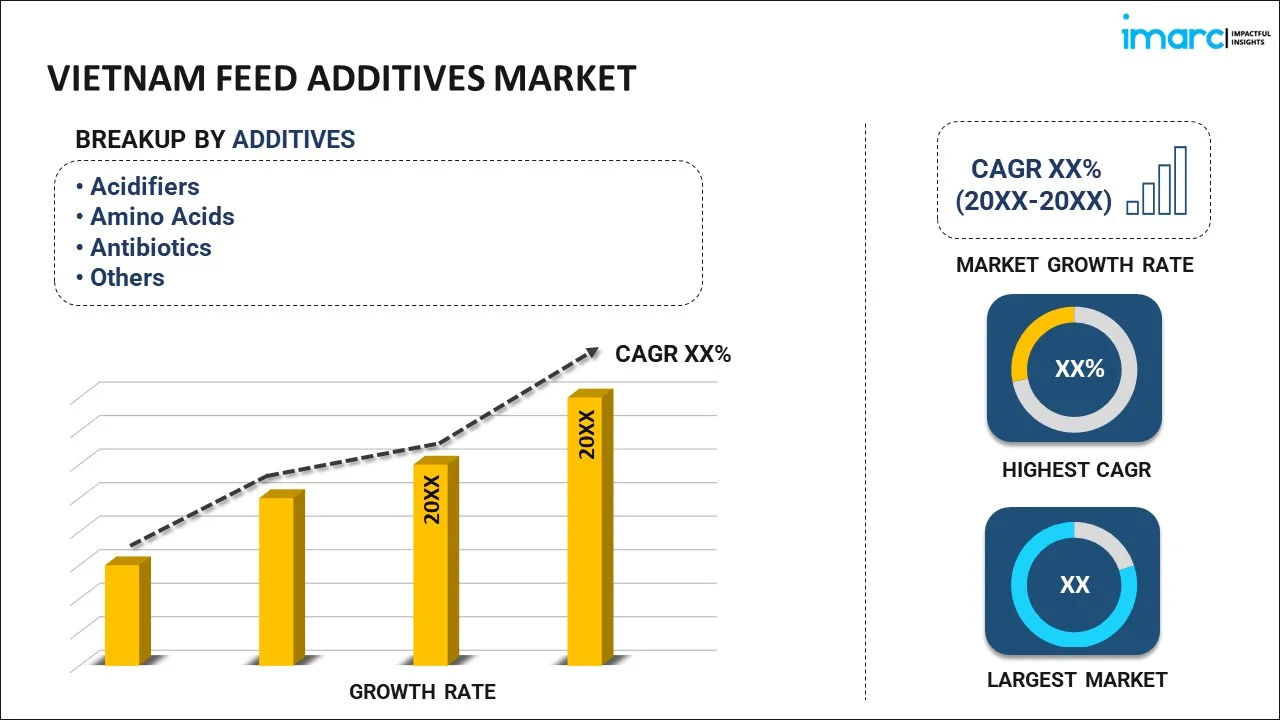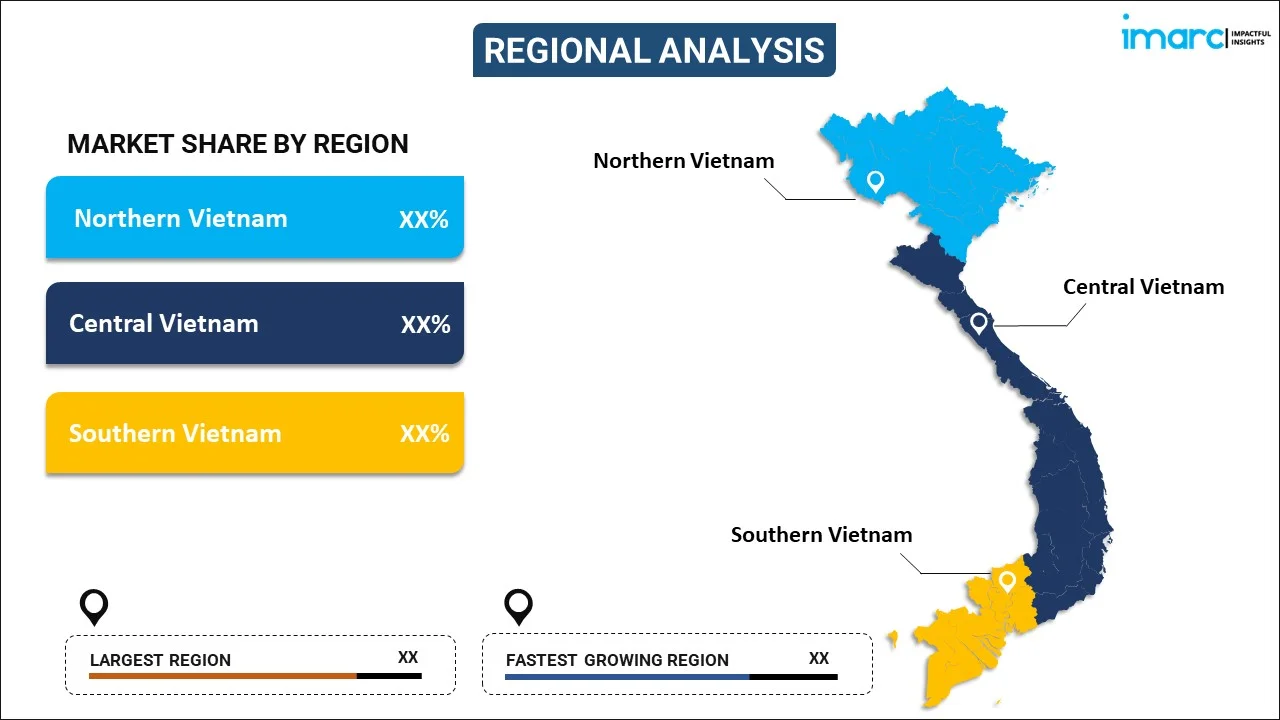
Vietnam Feed Additives Market Report by Additive (Acidifiers, Amino Acids, Antibiotics, Antioxidants, Binders, Enzymes, Flavors and Sweeteners, Minerals, Mycotoxin Detoxifiers, Phytogenics, Pigments, Prebiotics, Probiotics, Vitamins, Yeast), Animal (Aquaculture, Poultry, Ruminants, Swine, and Others), and Region 2025-2033
Market Overview:
Vietnam feed additives market size reached USD 164.6 Million in 2024. Looking forward, IMARC Group expects the market to reach USD 230.1 Million by 2033, exhibiting a growth rate (CAGR) of 3.80% during 2025-2033. The increasing demand for meat and poultry, the rising awareness among farmers, the strong export market in seafood and the availability of international products in the domestic market represent some of the key factors driving the market.
|
Report Attribute
|
Key Statistics
|
|---|---|
|
Base Year
|
2024
|
|
Forecast Years
|
2025-2033
|
|
Historical Years
|
2019-2024
|
|
Market Size in 2024
|
USD 164.6 Million |
|
Market Forecast in 2033
|
USD 230.1 Million |
| Market Growth Rate 2025-2033 | 3.80% |
Feed additives are substances added to animal feeds to improve their nutritional value, quality, and overall effectiveness. They play a vital role in enhancing animal health, growth, and productivity. These additives are meticulously formulated to ensure that livestock receives all the essential nutrients they need for optimal growth and development. The use of feed additives has become increasingly popular in modern agriculture to meet the rising demand for animal-based products, including meat, milk, and eggs. Some common types of feed additives include vitamins, minerals, amino acids, enzymes, and probiotics. By incorporating these additives, farmers can achieve faster growth rates in animals, better feed conversion ratios, and improved resistance to diseases. Antibiotics can be used as growth promoters and to prevent or treat diseases, although their usage is regulated due to public health concerns. Additionally, antioxidant additives help in preserving the quality of feed by preventing oxidation. Enzyme additives, on the other hand, aid in the better digestion of nutrients.
Vietnam Feed Additives Market Trends:
The market in Vietnam is primarily driven by the escalating demand for meat and seafood. This can be supported by the growing middle-class population, which is increasingly adopting a protein-rich diet. This increase in meat consumption necessitates enhanced livestock production, which in turn propels the need for high-quality feed additives to ensure animal health and productivity. Moreover, Vietnam's strong export market in poultry, pork, and seafood is encouraging farmers to focus on the quality and safety of animal products, propelling the consumption of feed additives that are compliant with international standards. Besides, government initiatives are also playing a crucial role in the market's expansion. Regulatory bodies are laying down stringent guidelines on animal feed quality and safety, pushing manufacturers to incorporate effective and compliant feed additives. Furthermore, the rising awareness among farmers has led to the adoption of various types of feed additives such as amino acids, vitamins, and enzymes that not only improve animal health but also contribute to sustainable farming practices. Apart from this, trade liberalization is creating a positive market outlook. Vietnam has signed several free trade agreements that ease the importation of high-quality feed additives from other countries. This availability of international products in the domestic market provides farmers with a broader range of options, thus fostering the market. Additionally, the country's strategic location and favorable climate make it an ideal place for livestock farming, further elevating the demand for feed additives. Also, the market is witnessing a rise in foreign direct investments and partnerships between local and international companies. These collaborations aim to leverage Vietnam's growing market by introducing global standards and technical know-how, thereby elevating the quality and competitiveness of Vietnam's feed additives on the global stage.
Vietnam Feed Additives Market Segmentation:
IMARC Group provides an analysis of the key trends in each segment of the market, along with forecasts at the country level for 2025-2033. Our report has categorized the market based on additive and animal.
Additive Insights:

- Acidifiers
- Fumaric Acid
- Lactic Acid
- Propionic Acid
- Others
- Amino Acids
- Lysine
- Methionine
- Threonine
- Tryptophan
- Others
- Antibiotics
- Bacitracin
- Penicillins
- Tetracyclines
- Tylosin
- Others
- Antioxidants
- Butylated Hydroxyanisole (BHA)
- Butylated Hydroxytoluene (BHT)
- Citric Acid
- Ethoxyquin
- Propyl Gallate
- Tocopherol
- Others
- Binders
- Natural Binders
- Synthetic Binders
- Enzymes
- Carbohydrases
- Phytases
- Others
- Flavors and Sweeteners
- Flavors
- Sweeteners
- Minerals
- Macrominerals
- Microminerals
- Mycotoxin Detoxifiers
- Binders
- Biotransformers
- Phytogenics
- Essential Oil
- Herbs and Spices
- Others
- Pigments
- Carotenoids
- Curcumin and Spirulina
- Prebiotics
- Fructo Oligosaccharides
- Galacto Oligosaccharides
- Inulin
- Lactulose
- Mannan Oligosaccharides
- Xylo Oligosaccharides
- Others
- Probiotics
- Bifidobacteria
- Enterococcus
- Lactobacilli
- Pediococcus
- Streptococcus
- Others
- Vitamins
- Vitamin A
- Vitamin B
- Vitamin C
- Vitamin E
- Others
- Yeast
- Live Yeast
- Selenium Yeast
- Spent Yeast
- Torula Dried Yeast
- Whey Yeast
- Yeast Derivatives
The report has provided a detailed breakup and analysis of the market based on the additive. This includes acidifiers (fumaric acid, lactic acid, propionic acid, and others), amino acids (lysine, methionine, threonine, tryptophan, and others), antibiotics (bacitracin, penicillins, tetracyclines, tylosin, and others), antioxidants (butylated hydroxyanisole (BHA), butylated hydroxytoluene (BHT), citric acid, ethoxyquin, propyl gallate, tocopherols, and others), binders (natural binders and synthetic binders), enzymes (carbohydrases, phytases, and others), flavors and sweeteners (flavors and sweeteners), minerals (macrominerals and microminerals), mycotoxin detoxifiers (binders and biotransformers), phytogenics (essential oil, herbs and spices, and others), pigments (carotenoids and curcumin and spirulina), prebiotics (fructo oligosaccharides, galacto oligosaccharides, inulin, lactulose, mannan oligosaccharides, xylo oligosaccharides, and others), probiotics (bifidobacteria, enterococcus, lactobacilli, pediococcus, streptococcus, and others), vitamins (vitamin A, vitamin B, vitamin C, vitamin E, and others), and yeast (live yeast, selenium yeast, spent yeast, torula dried yeast, whey yeast, and yeast derivatives).
Animal Insights:
- Aquaculture
- Fish
- Shrimp
- Others
- Poultry
- Broiler
- Layer
- Others
- Ruminants
- Dairy Cattle
- Others
- Swine
- Others
A detailed breakup and analysis of the market based on the animal have also been provided in the report. This includes aquaculture (fish, shrimp, and others), poultry (broiler, layer, and others), ruminants (dairy cattle and others), swine, and others.
Regional Insights:

- Northern Vietnam
- Central Vietnam
- Southern Vietnam
The report has also provided a comprehensive analysis of all the major regional markets, which include Northern Vietnam, Central Vietnam, and Southern Vietnam.
Competitive Landscape:
The market research report has also provided a comprehensive analysis of the competitive landscape in the market. Competitive analysis such as market structure, key player positioning, top winning strategies, competitive dashboard, and company evaluation quadrant has been covered in the report. Also, detailed profiles of all major companies have been provided.
Vietnam Feed Additives Market Report Coverage:
| Report Features | Details |
|---|---|
| Base Year of the Analysis | 2024 |
| Historical Period | 2019-2024 |
| Forecast Period | 2025-2033 |
| Units | Million USD |
| Scope of the Report | Exploration of Historical and Forecast Trends, Industry Catalysts and Challenges, Segment-Wise Historical and Predictive Market Assessment:
|
| Additives Covered |
|
| Animals Covered |
|
| Regions Covered | Northern Vietnam, Central Vietnam, Southern Vietnam |
| Customization Scope | 10% Free Customization |
| Post-Sale Analyst Support | 10-12 Weeks |
| Delivery Format | PDF and Excel through Email (We can also provide the editable version of the report in PPT/Word format on special request) |
Key Questions Answered in This Report:
- How has the Vietnam feed additives market performed so far and how will it perform in the coming years?
- What has been the impact of COVID-19 on the Vietnam feed additives market?
- What is the breakup of the Vietnam feed additives market on the basis of additive?
- What is the breakup of the Vietnam feed additives market on the basis of animal?
- What are the various stages in the value chain of the Vietnam feed additives market?
- What are the key driving factors and challenges in the Vietnam feed additives?
- What is the structure of the Vietnam feed additives market and who are the key players?
- What is the degree of competition in the Vietnam feed additives market?
Key Benefits for Stakeholders:
- IMARC’s industry report offers a comprehensive quantitative analysis of various market segments, historical and current market trends, market forecasts, and dynamics of the Vietnam feed additives market from 2019-2033.
- The research report provides the latest information on the market drivers, challenges, and opportunities in the Vietnam feed additives market.
- Porter's five forces analysis assist stakeholders in assessing the impact of new entrants, competitive rivalry, supplier power, buyer power, and the threat of substitution. It helps stakeholders to analyze the level of competition within the Vietnam feed additives industry and its attractiveness.
- Competitive landscape allows stakeholders to understand their competitive environment and provides an insight into the current positions of key players in the market.
Need more help?
- Speak to our experienced analysts for insights on the current market scenarios.
- Include additional segments and countries to customize the report as per your requirement.
- Gain an unparalleled competitive advantage in your domain by understanding how to utilize the report and positively impacting your operations and revenue.
- For further assistance, please connect with our analysts.

 Inquire Before Buying
Inquire Before Buying
 Speak to an Analyst
Speak to an Analyst
 Request Brochure
Request Brochure
 Request Customization
Request Customization



.webp)




.webp)












